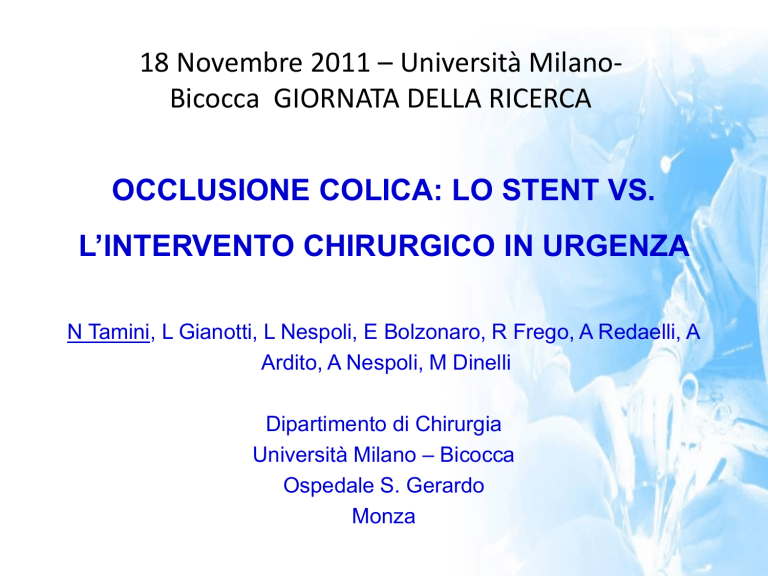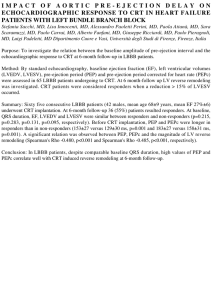median, range - Università degli Studi di Milano

18 Novembre 2011 – Università Milano-
Bicocca GIORNATA DELLA RICERCA
OCCLUSIONE COLICA: LO STENT VS.
L’INTERVENTO CHIRURGICO IN URGENZA
N Tamini, L Gianotti, L Nespoli, E Bolzonaro, R Frego, A Redaelli, A
Ardito, A Nespoli, M Dinelli
Dipartimento di Chirurgia
Università Milano – Bicocca
Ospedale S. Gerardo
Monza
BACKGROUND
• Up to 20% of patients with colonic cancer are admitted with symptoms of acute obstruction
• The majority of cases of acute colonic obstruction is due to colorectal cancer
• Emergency surgery for acute colonic obstruction is associated with a significant risk of mortality and morbidity and with a high percentage of stoma creation
(either temporary or permanent)
• Colon stenting may represent a valuable option both for palliation and as a bridge to elective surgery.
Phillips RK - Br J Surg 1985.
Mella J - Br J Surg 1997
Serpell JW - Br J Surg 1989.
Umpleby HC - Dis Colon Rectum 1984
Ansaloni - World Journal of Emergency Surgery 2010
Khot UP - Br J Surg 2002
Breitenstein S. - Br J Surg 2007
Villar JM - Surg Today 2005
January 2005-April 2011
Patients admitted with large bowel obstruction n = 157
Excluded from analysis for perforation-peritonitis n = 23
Non resectable
Successful n = 32 n = 34
SEMS
Oncology
Unsuccessful n = 2
Emergency operation with palliative intent
Clinical evaluation and staging n = 134
Emergency operation n = 49+2
Resectable n = 100
Surgeon judgment
Unsuccessful n = 2
SEMS attempt as a bridge to elective operation n = 51
Successful n = 49
Elective operation n = 49
Oncology
Non resectable patients (palliation)
• Bilobar multiple liver metastasis or involving the hepatic hileum or veins
• Lung metastasis
• Peritoneal carcinomatosis
• ASA > 4
• Karnofsky < 30
• Child C
Baseline characteristics of patients with SEMS placement (n=81)
Age [median, range], yr
Sex (male, %)
BMI [median, range], kg/m²
Weight loss > 10% in the last 6 months, n ° (%)
Co-morbidity, n ° (%)
Diabetes
Cardiovascular
Respiratory
Neurological
Gastrointestinal
Others
70 (25-96)
53 (65.4)
23.4 (15.4-46.9)
38 (46.9)
12 (14.8)
54 (66.6)
21 (25.9)
10 (12.3)
26 (30.1)
28 (34.6)
Site of obstruction, n°(%)
Left colon
Rectosigmoid
Transverse colon
Right colon
Primary cause of obstruction, n° (%)
Cancer
IBD
Diverticular disease
Adhesion
Type of stricture, n° (%)
Incomplete
Complete
Difficult SEMS placement, n° (%)
Length of procedure [median-range], min
29 (35.8)
45 (55.6)
6 (7.4)
1 (1.2)
74 (91.3)
2 (2.5)
4 (4.9)
1 (1.2)
45 (55.5)
36 (44.5)
35 (43.2)
30 (15-75)
Time from haspital admission to SEMS placement, Days
[median, range]
Cancer staging, n° (%)
II
1 (0-18)
16 (20.8)
III
IV
Succesful , n° (%)
Technical
23 (31.1)
35 (47.3)
81 (95.3)
Clinical 80 (98.7)
Time from SEMS to bowel canalization, hrs [median, range] 26 (6-72)
Short-term complications of SEMS (n=81)
Type of complication
Bowel perforation, n ° (%)
Stent migration, n ° (%)
Stent occlusion, n ° (%)
Arrhythmia, n ° (%)
Colorectal bleeding, n ° (%)
Abdominal or rectal pain, n ° (%)
1 (1.2)
4 (4.9)
3 (3.7)
1 (1.2)
4 (4.9)
6 (7.4)
Overall number of complicated patients 12 (14.8)
Baseline characteristics of palliative patients (n=32)
Age, y, median (range)
Sex, male, no. (%)
BMI, median (range)
Weight loss, no. (%)
Comorbidities, no. (%)
79 (35-93)
23 (71.9%)
23.1 (15.4-46.9)
20 (62.5%)
Diabetes 6 (18.8%)
Cardiovascular 24 (75.0%)
Respiratory 9 (28.1%)
Gastrointestinal 17 (53.1%)
Others 15 (46.9%)
Site of obstruction, no. (%)
Right colon 1 (3.1%)
Transverse colon 3 (9.4%)
Left colon 9 (28.1%)
Rectosigmoid 19 (59.4%)
Primary cause of obstruction, no. (%)
Cancer 29 (90.6%)
Inflammatory bowel disease 2 (6.3%)
Diverticular disease 0 (0.0%)
Adhesion 1 (3.1%)
Type of stricture, n ° (%)
Complete
Incomplete
Cancer staging, no. (%)
15 (46.9)
17 (53.1)
1 0 (0.0%)
2 0 (0.0%)
3 6 (20.7%)
4 23 (79.3%)
Time from hospital admission to SEMS placement, days, 2 (0-18) median (range)
Procedure time, min, median (range)
SEMS placement difficulties, no. (%)
26 (20-45)
14 (43.8%)
Long-term complications of SEMS (n=32)
Median follow-up: 19 months (95%CI 16-22)
Type of complication
Bowel perforation, n ° (%)
SEMS migration, n ° (%)
SEMS occlusion, n ° (%)
Tenesmus, n ° (%)
Recurrent abdominal pain, n ° (%)
Colorectal bleeding, n ° (%)
Clinical successful, n ° (%)
Overall number of compicated patients, n ° (%)
Hospital readmission, n ° (%)
1 (3.1)
4 (12.5)
3 (9.4)
7 (21.8)
7 (21.8)
8 (25.0)
26 (81.2)
14 (43.8)
11 (34.4)
Long-term survival (Kaplan-Meier curve)
Palliation
Stent “bridge” V.S. Chirurgia d’urgenza:
3 RCT
Results
PRIMARY OUTCOME
STOMA PLACEMENT: ES n=17 (57%) versus SEMS n=13 (43%) (p=0.30)
STOMA CLOSURE: ES n=9 (30%) versus SEMS n=4 (13%) (p=0.12)
SECONDARY OUTCOME
No statistically significant
ENDOSCOPIC PROCEDURE
Successo Tenico n=14 (47%)
Successo clinico n=12 (40%)
Technical failure n=16 (53%)
- 13 impossibile superare la stenosi con filo guida
- 1 malfuzionamento stent
- 2 perforazioni
These major side effects, associated with the unexpected high rate of technical failures, led the steering committee to interrupt the trial after 65 patient inclusions.
• PRIMARY OUTCOME: no difference in global health status between the treatment groups
• SECONDARY OUTCOMES: no differences in the secondary outcomes of mortality and morbidity between study groups
STOMA RATE: After the first operation:
SEMS 24/48 vs ES 38/51 (p=0.016)
After 6 months fup:
SEMS 27/47 vs ES 34/51 (p=0.35)
• STENTING PROCEDURE:
- Technical success 33/47 (70.2%) = clinical success
- SEMS-related perforations: 6/47 (12.8%)
Results
Baseline characheristics of resectable patients who underwent surgery
Age [median, range],yrs
Sex (male, %)
BMI, kg/m²
Weight loss
Co-morbidity, n ° (%)
Diabetes
Cardiovascular
Respiratory
Gastrointestinal
Neurologic
Others
SEMS n=49
69 (28-96)
30 (61)
24.1 ± 3.7
18 (36)
6 (12.2)
30 (61.2)
12 (24.4)
19 (38.8)
4 (8.2)
3 (6.1)
NO SEMS n=51
72 (40-95)
29 (57)
23.8 ± 4.2
24 (47)
5 (9.8)
25 (49.0)
8 (15.7)
11 (21.5)
3 (5.9)
5 (9.8)
P VALUE
0.09
0.66
0.70
0.30
0.18
Hemoglobin, [mean ± SD], g/dL
Albumin, [mean ± SD], g/dL
Cholinestarase, [mean ± SD], UI/mL
White cell, [mean ± SD], 10 3 cells/mL
Primary cause of obstruction, n ° (%)
Cancer disease
IBD
Diverticular disease
Adhesion
Type of stricture, n ° (%)
Complete
Incomplete
Time from admission to surgery, days
[median,range]
SEMS n=49
13.7
± 1.6
3.8
± 0.3
6107 ± 1904
9.5
± 3.5
45 (91.8)
0
4 (4.4)
0
21 (42.8)
28 (57.2)
6 (2-20)
NO SEMS n=51
13.0
± 1.8
3.7
± 0.4
6008 ± 2176
10.7
± 4.9
P VALUE
0.07
0.23
0.10
0.15
0.77
46 (90.2)
1 (1.9)
2 (3.9)
2 (3.9)
0.71
19 (37.2)
32 (62.8)
2 (0-23) 0.003
Type of resection and surgery, n ° (%)
Left colon
Rectum
Transverse colon
Right colon
Primary anastomosis
Diverting ileostomy
Laparotomy/laparoscopy, n °
Length of operation [median, range], min
Nodes harvested, median (range)
Positive nodes, median (range)
Microperforation by pathology, n ° (%)
Tumor staging, n ° (%)
II
III
IV
Chemotherapy, n ° (%)
Time from surgery to CT initiation [mean, SD], days
CT interruption, n ° (%)
SEMS n=49
35 (71.4)
9 (18.4)
3 (6.1)
1 (2.0)
48 (97.9)
4 (10.2)
30/19
NO SEMS n=51
31 (60.8)
4 (7.8)
3 (5.9)
4 (7.8)
44 (86.3)
9 (17.6)
51/0
P VALUE
0.37
0.20
0.70
0.38
0.03
0.44
0.0001
160 (105-430)
23 (10-41)
7 (0-12)
2 (4.1)
195 (65-560)
18 (5-35)
5 (0-12)
4 (7.8)
0.3138
0.08
0.10
0.18
0.75
11 (24.4)
22 (48.9)
12 (26.7)
21 (46.6)
64 (42)
2 (4.4)
12 (26.1)
19 (41.3)
15 (30.6)
17 (36.9)
101 (107)
4 (8.7)
0.33
0.19
0.20
SEMS
ASA Score, n ° (%)
II 40 (81.6)
III
IV
9 (18.4)
0
NO SEMS P value
0.0002
22 (43.1)
23 (45.1)
6 (11.8)
Short-term outcomes of resectable patients who underwent surgery
P VALUE
Resumption of oral feeding, days, median (range)
SEMS n=49
5 (2-12)
NO SEMS n=51
6 (3-12) 0.0654
Canalization to GAS, days, median (range)
Canalization to faeces, days, median (range)
Need of parenteral nutrition, no. (%)
Hartmann resection, no. (%)
Blood transfusion, no. (%)
Electrolyte abnormality, no. (%)
Wound infections, no. (%)
Urinary tract infections, no. (%)
3 (0-6)
4 (0-9)
10 (20.4%)
1 (2.0%)
17 (34.7%)
4 (8.2%)
13 (26.5%)
4 (8.2%)
3 (0-9)
5 (1-12)
26 (51.0%)
7 (13.7%)
30 (58.8%)
15 (29.4%)
28 (54.9%)
8 (15.7%)
0.2152
0.7700
0.0018
0.0399
0.0177
0.0098
0.0047
0.3580
Intra-abdominal abscess, no. (%)
Anastomotic leak, no. (%)
Peritonitis, no. (%)
Septic shock, no. (%)
Respiratory tract complications, no. (%)
Need of ICU transfer, no. (%)
Re-operation, no. (%)
Post-operative LOS, days, median (range)
Overall LOS, days, median (range)
Overall number of complicated patients, no. (%)
In hospital mortality, no. (%)
SEMS n=49
7 (14.3%)
6 (12.2%)
2 (4.1%)
2 (4.1%)
5 (10.2%)
5 (10.2%)
3 (6.1%)
10 (4-30)
18 (10-39)
16 (32.7%)
1 (2.0%)
NO SEMS n=51
20 (39.2%)
10 (19.6%)
5 (9.8%)
6 (11.8%)
19 (37.3%)
17 (33.3%)
10 (19.6%)
15 (4-125)
19 (8-128)
31 (60.8%)
1 (2.0%)
P VALUE
0.0066
0.4157
0.4367
0.2695
0.0020
0.0073
0.0521
0.0001
0.2190
0.0055
1.0000
ROC curve on surgical complications and time interval from SEMS placement to operation
Long-term complications of patients who underwent surgery
(median follow-up = 43.5 months)
New episode of intestinal obstruction, n ° (%)
Recurrent abdominal pain, no. (%)
Incisional hernia, no. (%)
Permanent stoma, no. (%)
GI bleeding, no. (%)
Tenesmus, no. (%)
New hospital admissions, no. (%)
Overall number of complicated patients, no. (%)
SEMS n=48
3 (6.3%)
6 (12.5%)
NO SEMS n=50
5 (10.0%)
12 (24.0%)
P VALUE
0.4832
0.1933
3 (6.3%)
3 (6.3%)
4 (8.3%)
4 (8.3%)
11 (22.9%)
11 (22.0%)
13 (26.0%)
6 (12.0%)
4 (8.0%)
17 (34.0%)
0.0410
0.0124
0.7410
1.0000
0.2673
12 (25.0%) 18 (36.0%) 0.2773
Long-term survival (Kaplan-Meier curve)
SEMS
NO SEMS
Log-rank
Conclusioni
• L’uso di SEMS per trattare l’occlusione colica è sicuro, fattibile ed efficace (esperienza endoscopista)
• SEMS per palliazione sembra promettente ma sono necessari ulteriori dati
• SEMS “as a bridge to elective surgery” dovrebbe essere considerata l’opzione ottimale.



